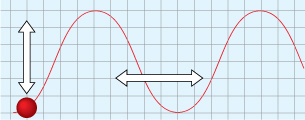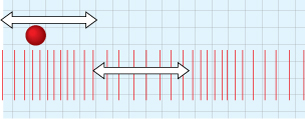Module 8—Mechanical Waves
 Lesson Summary
Lesson Summary
As you worked through this lesson, you should have developed partial answers to these questions:
- What are the properties of mechanical waves?
- What is the difference between a transverse wave and a longitudinal wave?
- How does the universal wave equation relate the frequency, speed, and length of a wave?
The mechanical waves discussed in this lesson require three things: some source of disturbance, a medium that can be disturbed, and some physical connection or mechanism through which adjacent portions of the medium can influence each other. To generate a wave, a point source, such as a water droplet, earthquake, or nuclear explosion, disturbs the medium. The energy of the disturbance is transferred from one point to another as the particles within the medium vibrate with simple harmonic motion. It is the transfer of energy in this manner that creates a mechanical wave that travels or propagates through the medium. The wave that transfers the energy is defined by several observable characteristics, such as speed, frequency, wavelength, and amplitude.
The difference between a transverse wave and a longitudinal wave is related to the orientation of the wave motion and the motion of the particle in the medium that carries the wave.

In a transverse wave motion, the medium vibrates parallel to the direction of the wave motion.

In the longitudinal wave motion, the medium vibrates perpendicular (transverse) to the direction of the wave motion.
The universal wave equation states that the product of the wave frequency and wavelength are always equal to the speed of the wave. Expressed as an equation, it is v = fλ.
Lesson Glossary
amplitude: the measure of the maximum displacement of a wave from the equilibrium position
crest: the highest point in a wave
equilibrium position: the position where the medium would normally rest
longitudinal wave: a wave in which the medium moves in the same direction as the wave
medium: the substance that acts as a carrier for a wave
point source: a source that radiates waves as if it were a point
transverse wave: a wave in which the medium moves at right angles to the direction of the wave
trough: the lowest point in a wave
universal wave equation: the speed of the wave is equal to the product of the wave frequency and the wavelength
wavelength: the distance between consecutive crests (or troughs)